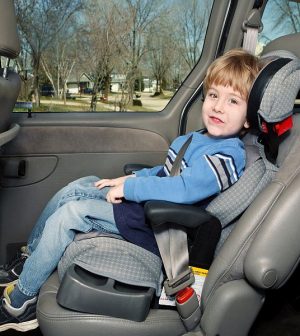- Navigating Your Midlife Crisis: Embracing New Possibilities
- City Raccoons Showing Signs of Domestication
- Mapping the Exposome: Science Broadens Focus to Environmental Disease Triggers
- One Week Less on Social Media Linked to Better Mental Health
- Your Brain Changes in Stages as You Age, Study Finds
- Some Suicide Victims Show No Typical Warning Signs, Study Finds
- ByHeart Formula Faces Lawsuits After Babies Sickened With Botulism
- Switch to Vegan Diet Could Cut Your Greenhouse Gas Emissions in Half
- Regular Bedtime Does Wonders for Blood Pressure
- Dining Alone Could Mean Worse Nutrition for Seniors
1 in 5 U.S. Kids Killed in Crashes Not Restrained Properly

If parents need more proof that car seats and seat belts save young lives, researchers now report that one in every five children killed in car crashes in the United States was unrestrained or improperly restrained.
The analysis involved nationwide data on nearly 2,900 traffic crash deaths involving children under the age of 15 between 2010 and 2014. It found that 13 percent of crash victims were inappropriately placed in the front seat.
The research team, from UT Southwestern Medical Center in Dallas and Harvard Medical School, “hypothesized that state-level policies related to child traffic safety would be associated with state mortality rates.”
And while the study found that the national crash death rate was 0.94 per 100,000 children a year, there were significant regional differences, the researchers noted in a UT Southwestern news release.
The South had 1,550 deaths and a death rate of 1.34 per 100,000 children per year, while the Midwest had 585 deaths and a death rate of 0.89 per 100,000 children per year. Other regions fared better: The West had 561 deaths and a death rate of 0.76 per 100,000 children per year, while the Northeast had 189 child deaths and a death rate of 0.38 per 100,000 children per year.
States with the most deaths were: Texas (346); California (200); Florida (144); North Carolina (132); Georgia (130); and Alabama (125). States with the fewest deaths were: Rhode Island (3); Alaska (4); Delaware, New Hampshire, and Vermont (5); Maine (7); and Hawaii (9).
According to senior study author Dr. Faisal Qureshi, associate professor at UT Southwestern, and colleagues, “No prior study has examined trends in motor vehicle crash-related pediatric mortality across states and factors associated with geographic variation at the state or regional level.”
The researchers explained that “this geographic variation is important because laws regarding child traffic safety remain within the state domain.”
The national data also showed that nearly 9 percent of drivers were under the influence of alcohol. And vans and minivans had the fewest fatalities, followed by pickups, SUVs and cars.
Qureshi and his colleagues concluded that just a 10 percent improvement in child-restraint use in vehicles would prevent about 232 deaths a year, or more than 1,100 over five years.
The findings were published online May 23 in The Journal of Pediatrics.
More information
The U.S. Centers for Disease Control and Prevention has more on child passenger safety.
Source: HealthDay
Copyright © 2025 HealthDay. All rights reserved.










